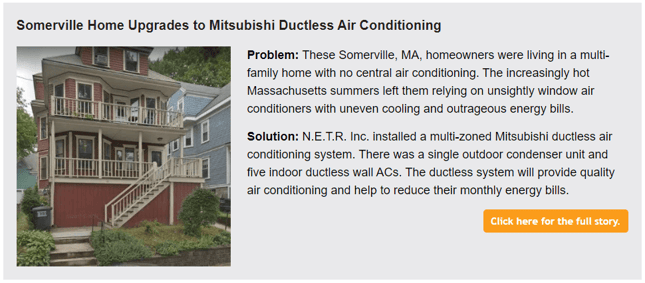.webp?width=200&height=75&name=blue-ridge-heating-air%20(1).webp)






And, we’ll look at how these apply specifically to HVAC companies. But, before that, let’s talk about the overall goal behind creating great content.
 Using Content to “Set the Table”
Using Content to “Set the Table”We use the term “Setting the Table” all the time at Comfort Media. It’s the idea of presenting a prospective customer with everything they need to make a decision before they even speak with a salesperson.
It’s much like how you’d make sure a dinner guest has a plate, utensils, napkins, and glass before serving food. Your content should help people understand the services and products you offer, answer their questions, and help convince them you’re the company they should hire. Now, let’s look at how to do that.

To make a list of topics to write about, find out what questions your customers ask the most.
The secret weapon? Your employees. Start with the people answering the phones.
Ask them what questions they hear most. Find out what answers your techs and sales team give people over and over again.
Then, write a blog post explaining each of them. This strategy achieves a few things. First, you’ll attract people to your site by offering information on a topic they’re likely to search. Some good SEO practices help out here, too.
Next, you’re showing people you’re not only an expert on all things HVAC, but you also know how to answer their exact question. That makes them more likely to click a link or call for an appointment.
In the digital marketing world, “Social Proof” is evidence from a prospect’s peers that reinforce your point.
Probably the most common example is a glowing, 5-star Google Review. A prospective customer sees that someone who was in their shoes was delighted with your service. Now, they’re more inclined to call you. But, you don’t have to wait for a review to provide social proof.

Case studies are a great way to get it out there. Speak to the customer’s perspective in these as much as possible.
What concerns did they have going in to the project? What made them choose you over a competitor? And, what were they most impressed with about the job?
Your sales team or lead techs can ask homeowners and property owners before and after a job. Not only will you get honest, positive statements. But, they also speak to the same concerns and expectations your next customer will have. When you show how satisfied your customers are, your reader is more confident they’ll get the same excellent treatment.
Yes, we know you know what tonnage is. And, exactly how a heat pump transfers thermal energy. But guess what? Your readers don’t care that much.
That doesn’t mean they’re ignorant or have their head in the sand. Instead, the exact ways things work usually don’t concern them. Look at it this way: Do you need to know how an engine works to buy a car? Or, just that this engine will keep you on the road?
If your posts only appeal to other people the industry, other people will leave your site before making contact or clicking to another page. Instead, focus on the benefits of whatever you’re discussing. Tell people how what you’re offering will save them money and make their home more comfortable.
Don’t worry too much about explaining all the technical stuff. And, use laymen’s terms as much as possible. The more casual you sound, the better.
You can supplement those posts with FAQ entries. Or, create other entries that explain some of the terms and technology.
This way, you don’t need to take a detour when you want people to understand a complex concept. Instead, offer them a link from your main article to the FAQ or explanatory page. Then, people who are curious about the nuts and bolts can learn more. Everyone else can stay on topic.
The best blog post in the world doesn’t mean anything if people don’t take the next step. You want someone reading your article to pick up the phone or fill out a form that gets them into your sales funnel.
You do this using a call-to-action. In this case, that’s a button with a quick request on it: “Click Here to Download our Brochure,” or “Schedule Your Free Consultation.” Even just “Call Now” with your phone number. In fact, here’s another one now:
A few years ago, all you needed were 300-word articles to make Google happy.
Now, the best SEO practices recommend writing articles over 1,000 words. How do you keep someone on the page long enough to read something that long? Add some graphics. And, keep your paragraphs down to just two or three sentences.
Stock photos, pictures from jobs, infographics — anything relevant that breaks up the text keeps people interested. Here’s my rule of thumb (or, rather index finger): Once I’ve laid out a new piece of content, I start at the top and flick the trackwheel on my mouse over and over until I reach the end. If at any point, I stop and only see text — no images, no calls-to-action — then I add something.

Don’t fall into the trap of writing a few blog posts, then forgetting about it for a while. To stay on top of this, create a content calendar.
Come up with your list of topics to write about for the next quarter or so. Commit to one day a week when you’ll release a post. Adding content regularly is an important part of driving traffic to your site. And, each piece should do its part in getting someone to book an appointment.
So, get writing! Prepare as many as you can in advance, and then schedule them to post on the day you’ve chosen. This way, you’ve got plenty ready to go for when you’re too busy to write more.
Now that you’ve got some great articles on your site, it’s time to make them work for you. Use them as part of your overall sales and marketing strategies.
Posting them on social media is a good start. This practice keeps your Facebook page active and generates traffic to your site. But don’t stop there. Include your latest posts in your emails. When you’re announcing a special on air conditioner tune-ups, for example, include a link to the benefits of preventative maintenance. Finally, make sure your sales team knows what’s available. If you’ve been asking them for suggestions, then you’re creating content they can use.
We had a client ask for a specific article about the size of ductless mini splits. Their salespeople kept running into this question and could never answer it quickly.
Now, they text or email people a link to the article and move the conversation forward. It was an easy piece to prepare, and it’s helping close sales all the time. If you have more questions about creating great content for your HVAC company, get in touch with us! We’re happy to talk strategy and help you grow.

About the Jack Firneno:
.webp?width=200&height=75&name=blue-ridge-heating-air%20(1).webp)





